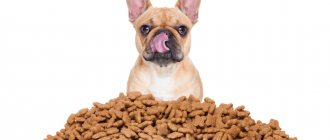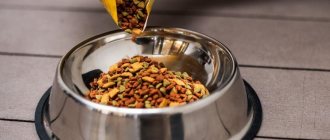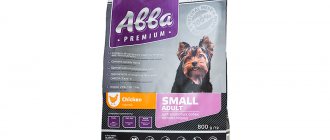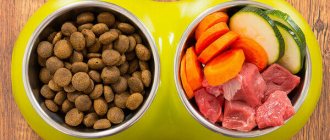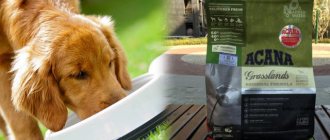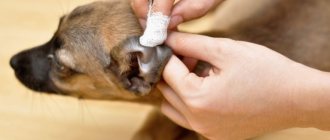How to properly switch a puppy or adult dog to another food
In this article I will talk about the features of changing food for a puppy and the basic rules that will help you switch your dog to a different food without harm to health. I will consider the nuances in this process, for example: the choice of new food, the animal’s reaction and the main problems that usually arise. I will also answer questions about what to do if the dog refuses to eat a new food.
Why switch your puppy to another food?
However, inexperienced breeders may have another question: why switch the puppy to another food if the pet feels great on the current diet? Everything is simple here: the pet is growing, and therefore its diet will have to be changed in any case.
True, when feeding “natural” all this is not very relevant, but when using dry or canned food it is more than relevant. The problem is that puppy diets contain a lot of nutrients, micro and macro elements. If you continue to feed them to a grown animal, it becomes difficult to avoid obesity and heart problems (as well as kidneys and liver). This is due to age-related slowdown of metabolism.
How to choose
Each dog has an individuality, with its own tastes and problems, but fortunately, today, there is a huge selection of food that can suit any picky dog.
Food from the common table is contraindicated for the dog. When choosing food for an animal, you should focus on industrially produced diets.
It is worth remembering that high-quality and specialized food is difficult to find in regular stores, but if you succeed, you are lucky. And if not, don’t worry, usually there are more individual options in pet stores or veterinary clinics; in any case, you can order the food you need in a store or have it delivered to your home from the Internet.
Quality puppy food is hard to find in stores
Second point. Watch for the presence of various dyes and carcinogens in the composition.
Third, consider your pet’s age, activity level and individual characteristics (for example, dry food for sterilized ones). Discuss the diet change with your veterinarian and look for reviews online.
Transfer to special feed
The individual needs of the animal, associated with exhaustion, recovery from illness or surgery, require increased feeding. Especially for such cases, manufacturers produce food in the form of pastes that are suitable for force feeding.
Special foods are a temporary measure because they contain significantly higher carbohydrate content.
The transition to special food is made on the recommendation of a veterinarian. Depending on the condition of the animal, an enhanced industrial or gentle natural diet is prescribed. In cases of severe dysbiosis, impaired digestion of food, or serious problems with the gastrointestinal tract, it is more logical to switch the dog to a natural diet.
What to do if the dog refuses to eat
Various factors can influence food refusal.
1) The food itself does not have enough chemicals; it does not attract the dog with its smell/taste.
2) You changed the position itself (taste), forgetting about the pet’s preferences.
3) The consistency is not suitable for dogs. For example, food is too hard.
In such cases, I would try to look for a replacement with a similar composition (modern choice allows this). You can also leave food that your pet likes.
If the puppy refuses to eat, you can increase physical activity
A good option would be to increase physical activity for the animal, because most of our dogs live in apartments and lead a sedentary lifestyle, and do not completely waste energy.
If you've switched to a higher-quality, less-flavored food, try adding canned food or treats to enhance the flavor. Change the position itself (composition, taste).
In addition, you can simply ignore the problem if you are sure that you will not harm your pet.
How to tell if your dog is responding well to a new food
Understanding that a new diet is a good fit is much easier than it would otherwise be.
The dog eats more willingly and may ask for more. The external condition of the pet improves: the quality of fur, nails, teeth. Over time, dandruff and other external skin diseases disappear. A healthy shine appears. If it is a puppy, then healthy height and normal weight. Brilliant eyes. Increased activity.
The dog does not chew food, but swallows it in pieces, tearing them off with its molars. The pet’s gastrointestinal tract best digests pieces of food (with the exception of vegetables and dairy products).
How to switch a dog from one dry food to another
We can be forced to switch a dog from one dry food to another by various factors, including:
- old food is not suitable for the dog (an allergy has developed, the dog looks bad, is losing weight, the hair does not shine, etc.);
— there is no way to buy old food (they stopped producing it, stopped importing it into the country, etc.)
— you’re not happy with the price (you can’t afford such expensive food);
— you want to switch your dog to more expensive food.
It is impossible to list all possible translation options, but this is not so important, the main thing is to translate the dog correctly so as not to upset the stomach. After all, as they wrote earlier, a dog is a constant animal, and constant in everything, and any change can lead to negative consequences.
In order for a dog to switch to a new food well, it must be given, starting with very small portions, to see how the body reacts, because anything new that the dog has not eaten before can cause allergies.
If you are switching your dog from one food to another (from different manufacturers), then try to choose the same position of the food, i.e. If you fed the dog “chicken and rice” food, then switch to “chicken and rice”; after a complete transition, you can subsequently transfer the dog to another position, but you should not do this right away. True, there is an exception, this is the food of the “lamb with rice” position, as well as other hypoallergenic foods.
So, let's derive a formula that can easily and simply transfer a dog to another food. You can transfer a dog in a few days (2-3 days), but it is better to extend this event over a week, for your own peace of mind, and on the first day you need to give nothing at all - 1-2 grams to see the dog’s reaction.
The formula goes like this (“daily food intake for a dog” divided by 7) and as a result we get the amount of food that can be given to a dog per day so as not to cause stomach upset.
Now let's look at everything in more detail, or rather in practice:
We have a toy terrier weighing 3 kilograms, the dog’s daily requirement is 65 grams of food, divide 65 by 7, and we get 9 grams and a penny, we remove these pennies, and it turns out that we can give the dog 9 grams of new food per day, and accordingly take 9 grams of the old one.
The exact formula for switching a dog to a new food
New food - 1-2 grams, old food - 63-64 grams;
Transfer to another dry food: how to do it correctly?
Why is a gradual transition to a new diet so important? What happens if the usual food is immediately replaced with a new one?
Features of digestion in dogs and cats
The digestive system of cats and dogs is designed in such a way as to “remember” food and digest well those foods that the pet eats regularly. The pet's body produces a certain set of enzymes that are needed to digest and assimilate familiar food. But when a new product is introduced into the diet, these enzymes are no longer enough. The body has to rebuild and produce other enzymes.
If the diet is changed too often or abruptly, the digestive system does not have time to adapt and the pet may experience metabolic disorders, digestive disorders and severe allergic reactions. To prevent this from happening, the transition to a new food must be done gradually and correctly. There are two ways to do this.
Transfer from one food to another: two ways
1 way. Removal
- At each feeding, 1/7-1/10 of the food is removed from the standard volume of a single portion, and a new one is added in its place.
- Every day the number of pieces of new food increases by 1.
- Thus, in 7-10 days you will completely replace the old food with a new one.
Disadvantage of this method:
Dry food can stay in a dog’s stomach for quite a long time. If, when switching to a new food, you see a negative gastrointestinal reaction or manifestations of an allergic reaction, you will not be able to determine the exact cause. Perhaps this is a new food, or perhaps a conflicting reaction to the combination of ingredients from both foods that are in the dog’s stomach.
Therefore, there is another way.
Method 2. Transfer with a break to natural nutrition
Any natural food (meat, fish, porridge, vegetables) contains much more moisture. Such food undergoes the digestion process faster and does not linger in the stomach for as long as dry food.
Unfortunately, the natural type of feeding has many disadvantages:
- At home, it is difficult to balance the composition and proportions of ingredients to ensure that the dog/cat receives a complete supply of all nutrients and vitamins. An imbalance in this case can lead to disruptions in the functioning of the animal’s body.
- Such nutrition carries less energy. A growing body or, for example, a sports dog or an active cat may not have enough energy for life. This also leads to a malfunction in the animal’s body.
- Preparing natural food takes much more time and resources of the owner himself. Often such food is more expensive than properly selected, balanced, high-quality dry food.
However, temporarily, for transferring from one dry food to another, natural nutrition becomes a good intermediary. It allows you to isolate one food from another and avoid ingredient conflicts.
How to transfer from one food to another through natural nutrition?
- For 1-2 days, the dog/cat is completely switched to natural food (in accordance with the needs for animal proteins, carbohydrates and vitamins).
- After 1-2 days, the dog/cat is offered new food (without mixing with the old one). Next, we maintain the diet of the new dry food for 7-10 days and draw conclusions whether it is suitable for the animal or not.
Nothing complicated, do you agree? However, these simple steps will help protect your pet from difficult health problems.
Be careful and don’t forget that pets trust us with themselves! How can we let them down?
We switch the dog from dry food to natural food. Veterinarian advice
The number of adherents of natural food for pets is constantly increasing. It is difficult to overestimate the benefits of quality products for a dog’s body. But not every owner knows how to properly switch their pet to a natural type of feeding and not harm its digestive system.
We will talk about how to make this process comfortable for the animal’s digestive system. We’ll also talk about the mistakes that owners make as a result of the lack of special knowledge about the physiology of their four-legged pet.
Abrupt transition to natural food and its consequences
Even the most loving and caring owners make a number of mistakes when switching an animal from a dry diet to natural products.
Veterinarians say that the most common of these is a sudden change in food. The consequences of such a rash decision will be:
1. Disturbances in the gastrointestinal tract. The body simply does not have time to adapt and digestive upset occurs. This is due to the fact that a large amount of pancreatic enzymes is not needed to digest ready-made diets.
And after a few months, its function decreases. The finished granules are presented in the most accessible form, so the fermentation process takes a minimum period of time.
Digesting natural products requires an impressive amount of enzymes, so it will take time to restore the functioning of the pancreas;
2. Refusal of food. Just yesterday the dog received his favorite dry granules with an attractive taste, and already in the morning a full bowl of porridge and vegetables is placed in front of him. It’s good if the owner adds aromatic beef bone or meat by-products to it.
In this case, the translation process will go much faster. But not every dog is ready to give up its usual diet and easily accept fermented milk products, cereals, fruits and vegetables;
3. Feeling unwell. A sudden transition from the usual food will invariably cause indigestion, flatulence, and heaviness in the stomach. The dog becomes lethargic and refuses to eat or walk.
Discomfort may also manifest itself as apathy or aggression, depending on the animal's temperament. After all, the dog does not understand why they stopped feeding him his usual food.
This is not the entire list of negative aspects that are associated with a sudden change in diet. It should be remembered that each pet is individual and requires a special approach.
Scheme for transferring a dog from natural to dry food
Veterinarians recommend adhering to a certain regimen that will make the process of switching to ready-made diets more gentle on the digestive system.
Thus, the following ratio of natural products and dry granules should be observed:
- 1-5 days 75% nat. Products: 25% granules;
- 6-10 days 50% nat. Products:50% granules;
- 10-15 days 25% nat. Products: 50% granules;
- From 16 days 100% ready-made dry diets.
This is important: Experts remind you not to mix fresh ingredients and dry food in the same bowl. The only exceptions are those pets who flatly refuse to even try drying. In this case, you can mix a small amount of granules into the usual diet so that the dog gets used to their taste. In other cases, dry food is given in the morning, and natural food in the evening. Or vice versa.
You may also find our article useful: Is it possible to combine dry dog food and natural food?
Scheme for transferring from a dry diet to natural feed
To ensure that the process of transferring a dog from ready-made diets to a natural type of feeding is as gentle as possible and does not cause inconvenience to the pet, simple rules should be followed.
Veterinarians remind us that there is a classic scheme recognized by experienced dog handlers and veterinary nutritionists:
- The transition from dry granules to natural food should be gradual . The minimum period for optimizing the functioning of the pancreas is 14 days for a HEALTHY animal. Only after 2 weeks can you count on the amount of enzymes in your pet’s body being sufficient to digest and absorb all nutrients;
- Separate meals . There is no need to add a couple of pieces of meat to a bowl of granules or fill them with kefir. In this way, you can only get indigestion and worsen your pet’s condition. The optimal solution would be granules during the morning feeding period and natural products in the evening. Or vice versa;
- Gradually increase the amount of natural products in your pet’s diet. An attempt to immediately replace half of the daily food intake with natural products will lead to dire consequences. Lack of the required amount of pancreatic enzymes will not allow food to be completely digested. Consequently, the process of decay begins in the intestines. And after a few days, the dog experiences gastrointestinal dysfunction (inflammatory processes, decreased peristalsis, flatulence, diarrhea or constipation).
Transfer to wet food
It will also take time to switch your dog to wet feeding. This should be done gradually, even if the four-legged animal happily eats the food offered.
Straight
To transition to natural food, you can mix wet food. You should start by taking it in the morning and replacing ¼ of the serving. After 3-4 days, replace ½ portion. Next, morning feeding is completely replaced with wet food.
Observing the dog will help you orient yourself correctly and after another 2-3 days you can replace the evening feeding.
Natural food is more balanced, there may be no need to make a complete transfer, but replacing one of the two feedings is quite possible.
From dry food
Most dogs easily switch from dry to wet food. However, the translation should be done gradually. The first feeding can be done by making a mixture of wet food and dry food. Don’t do too much, in case the dog refuses your “treat”.
When mixing in important feed, replace only ¼ of the feed. If everything goes smoothly, monitor the condition. After 2-3 days you can already replace ½, then the full norm.
When switching to wet food, you cannot limit it to watering. Water should always be freely available to the dog.
From other canned food
When changing one canned food for another, think about the need for this action. If you make changes in your diet, then it will be towards natural foods.
If you decide to feed canned food, then this should be done gradually. Since you can’t feed the whole jar at once, and store the rest for a long time in the refrigerator, give preference to small packaging.
Initially, you can offer a new food. If the dog refuses to eat, add it to the usual one, but not in large quantities.
Transferring a puppy from dry food to natural products
A small pet should be switched to a natural type of food if, when using a premium diet or food from the Holistic category, it has an intolerance to this food. If the basis of the daily menu is economy-class granules, then natural nutrition will be much better and more beneficial for a growing body.
The owner must adhere to the same basic rules as when transferring an adult to natural products. When compiling a diet, it is necessary to take into account the need to include in its composition:
- 50% protein food . These are meat by-products, meat, fish, dairy products. At the same time, the amount of by-products should not exceed 15%, and the content of the fermented milk component should not be lower than 15-25%;
- 25% of the puppy’s diet is allocated to vegetables and fruits . It is important to remember that the use of raw potatoes and fresh cabbage is unacceptable. You should also not get carried away with fresh beets. It causes loose stools;
- 22% of veterinary nutritionists recommend consuming cereals . The optimal solution would be to use buckwheat, rice, and oatmeal. In rare cases, it is possible to introduce pearl barley, barley or wheat into the diet. Millet, corn or semolina lead to disruption of the gastrointestinal tract and are not recommended for feeding dogs;
- 3% should be sources of vitamins and minerals. This can be brewer's yeast or meat and bone meal, fish oil or ready-made vitamin and mineral complexes.
This is important: In order not to create excessive stress on the pet’s digestive system, experts recommend pouring fresh broth into the dry granules at the initial stage. This will help teach your baby to eat soft food. You can also switch him to canned food.
If for an adult dog the transfer is carried out within 14 days, then for a baby it is better to slow down the pace somewhat and give him time to adapt. The ideal solution would be the duration of each stage being 5-7 days:
- 25% natural feed: 75% soaked;
- 50% natural feed: 50% soaked;
- 75% nat. Feed: 25% soaked;
- 100% nat. Stern.
If your baby refuses to try natural foods, then you should gradually add fresh minced meat (cottage cheese and other soft ingredients) to the soaked granules into his diet.
Transfer to natural feeding
It will not take much time to switch to natural feeding. Dogs willingly eat natural food. With constant feeding of dry food, the animal happily accepts natural food. However, the digestive system cannot immediately begin enzymatic processes; this takes time.
Don't add too many nutrients to your diet at once. Offer one daily. This makes it easier to identify the food that the body will not accept. The intestines may react with unformed feces - this is normal. If this continues for several days in a row, the transfer should be carried out even more slowly.
The transfer is carried out over 12-15 days, gradually adding new components to the diet.

